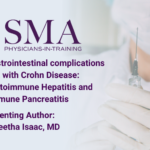Abstract | May 5, 2021
Autoimmune Gastrointestinal complications in a patient with Crohn Disease: Coexisting Autoimmune Hepatitis and Autoimmune Pancreatitis.
Introduction:
Inflammatory Bowel disease (IBD) frequently has extra-intestinal manifestations, of which Hepatopancreaticobiliary (HPB) complications are the most common. Of the HPB manifestations, Primary Sclerosing Cholangitis is the most common and Autoimmune pancreatitis(AIP) is one of the less common HPB manifestations of IBD[1].Most studies are reported in the east where the prevalence of AIP was found to be 4.6/100,000.AIP in the west is still not well recorded, and prevalence of AIP associated with other autoimmune conditions are even less reported [2].We present a patient, with Crohn’s disease, who presented with autoimmune hepatitis and autoimmune pancreatitis.
Case Presentation:
45-year-old African-American lady with Crohn’s disease, post small bowel resection, on Certolizumab, a monoclonal antibody specific to TNF- A, presented to us with mild abdominal discomfort and chills. She had a reported recent diagnosis of autoimmune hepatitis based on liver biopsy 1 week ago. On examination, she generally unwell, tachycardic and normotensive. She was drowsy but arousable and also had mild scleral icterus. She had mild epigastric tenderness to palpation, but no guarding or rebound. Bowel sounds were present. Examination of cardiovascular and pulmonary systems were unremarkable. Initial investigations showed deranged liver functions (LFT): Aspartate aminotransferase 622 and Alanine aminotransferase 419, total bilirubin 13.1 and direct bilirubin 10.5, with elevated Alkaline Phosphatase of 274.Amylase was 188 and Lipase was 287.Computerised tomography of Abdomen showed heterogeneous appearance of hepatic parenchyma and inflammatory changes around the pancreas indicating acute pancreatitis (Fig 1). Recent investigations 1 week prior to presentation showed IgG4 levels over 2000+, Anti-smooth muscle antibody 1:160.
Final Diagnosis:
Autoimmune Hepatitis and Autoimmune Pancreatitis
Management and Follow-up:
Patient was managed as for AIP with AH and was started high dose prednisolone, rifaximin and lactulose. Following adequate management with steroids, patient improved clinically and was asymptomatic on day 7 of admission. Her diet was advanced as tolerated and she was discharged well on steroid therapy with plans to follow up in GI clinic in 10 days.
Learning Objectives
- IBD frequently has extraintestinal manifestation, of which Hepato-pancreatico-biliary manifestation are the
commonest. AIP is one of the less common HPB manifestations. - The diagnostic criteria for AIP – the “HISORt” criteria, is most commonly used in the US and includes the presence of one or more of the following:
- Diagnostic Histology
- Characteristic Imaging on computed tomography (CT) and/or pancreatography
- Elevated serum IgG4 levels on Serologic testing
- Other organ involvement
- Response of pancreatic and extra pancreatic manifestations to glucocorticoid therapy
- AIP often responds to glucocorticoids with improvements in clinical manifestations and potentially preventing
complications. Time to response is variable, usually ranging 2 weeks to 4 months. Follow up studies include serum
IgG4 levels, liver function tests, and occasionally by computed tomography (CT) scan while on therapy

